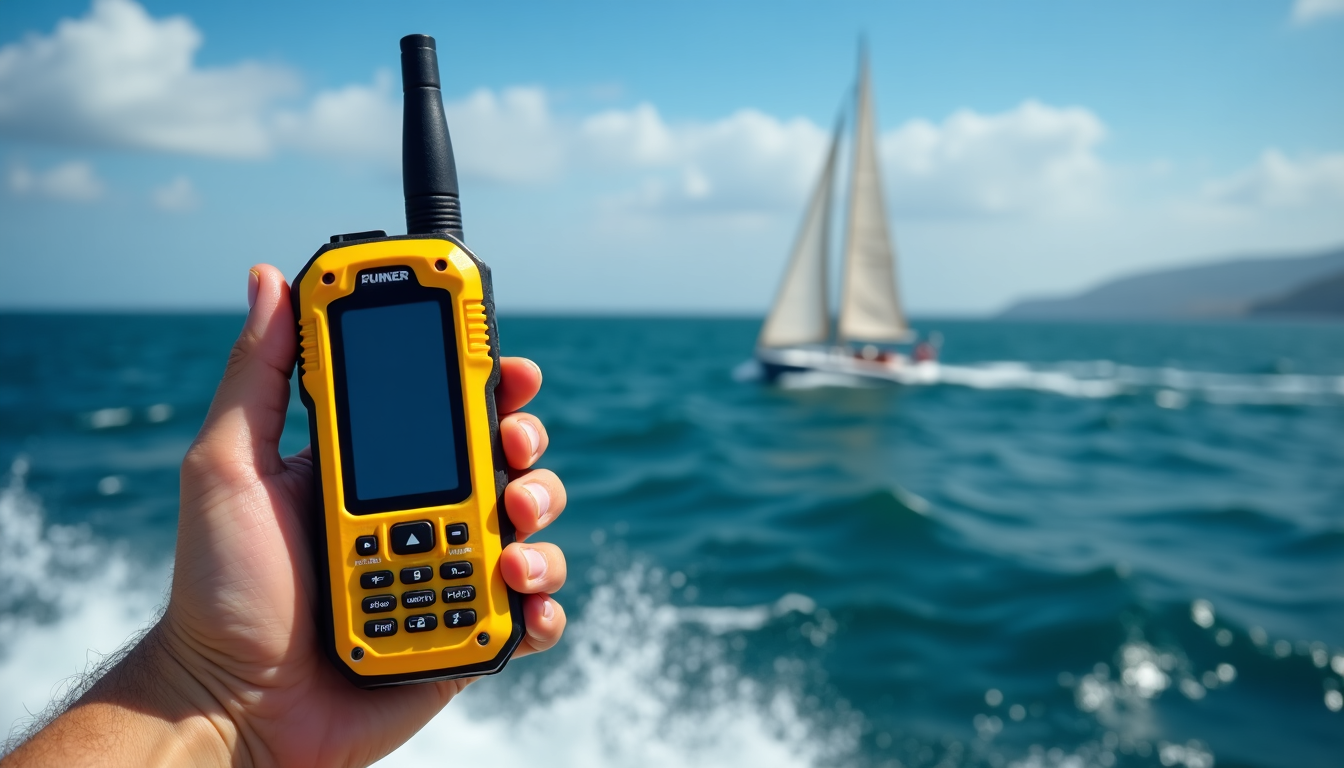Marine VHF Portable Radio Review: Our Expert Verdict

Clear communication at sea plays a vital role in safety and navigation, and marine VHF portable radios are indispensable tools for every vessel. These compact yet powerful devices become lifelines for boaters and enable clear communication with other vessels, coast guard stations, and marine rescue services. They prove their worth during routine operations and emergencies.
Our complete review gets into the latest marine VHF portable radio models and compares their battery life, DSC capabilities, and waterproof ratings. You will find detailed analysis of leading brands like Standard Horizon, Icom, and Uniden. The review also gives you practical information about power output, GPS integration, and emergency features that help you make smart buying decisions.
Top Features of Marine VHF Portable Radios
Today’s marine VHF portable radios combine advanced features with compact, rugged designs that boost communication reliability and safety at sea. These sophisticated devices have evolved by a lot and provide significant capabilities. Maritime operations depend on these indispensable tools.
Waterproof and Floating Designs
Handheld VHF radios today come with reliable waterproof construction. Many models have earned an IPX8 rating that lets them work perfectly even after complete submersion. Premium models feature floating designs that automatically activate strobes when they touch water, which makes recovery substantially easier if they fall overboard. Premium models now include this dual combination of waterproofing and buoyancy as a standard safety feature.
Power Output and Range
Handheld VHF radios operate at six watts of transmit power, compared to fixed-mount units that deliver 25 watts. The radio’s effectiveness relies more on antenna height than power output. Handheld units provide a range of three to eight miles. Fixed-mount radios extend this reach to 15-20 miles. The line-of-sight communication principle makes antenna height a crucial factor in determining range. An 8-foot antenna positioned 12 feet above sea level can reach approximately 4.5 miles.
Battery Life and Charging Options
Modern units employ advanced Lithium-ion and Lithium polymer batteries that deliver:
- 7-20 hours of operation between charges
- Battery life spans 18-24 months with proper maintenance
- Quick chargers and USB ports provide flexible charging solutions
GPS and DSC Capabilities
GPS and Digital Selective Calling (DSC) technology has transformed marine safety completely. These features enable:
- Quick position updates when emergencies strike
- Direct distress signals that include exact location details
- Specific boat-to-boat communication through MMSI numbers
Additional Safety Features
Modern models come with several safety features to boost user protection. Noise-canceling technology helps users communicate clearly in difficult environments. The devices automatically save the last 20 seconds of transmissions to prevent loss of vital information. NOAA weather alerts and emergency strobes add extra safety capabilities that protect users effectively.
Comparing Top Marine VHF Portable Radio Models
Top manufacturers have created distinctive marine VHF portable radios with unique feature combinations for different maritime needs. Let’s get into the standout features of the best models available today.
Standard Horizon HX890
The HX890 delivers an impressive 27-hour battery life during standby monitoring. Built to military standards, this rugged device comes with an IPX8 waterproof rating and floats in water while featuring emergency strobe lights. Maritime professionals will appreciate its large screen that’s easy to read and the quick charging capabilities.
Icom M94D
The Icom M94D marks a most important advancement as the world’s first handheld marine radio with integrated AIS capability. The radio packs 6 watts of transmit power and comes with a high-capacity 2400mAh Li-ion battery that runs for 10 hours. Its strong communication features include a powerful 1500mW speaker that delivers clear audio even in noisy maritime environments.
Uniden MHS75
The Uniden MHS75 is a compact radio with all the key features you need. Its battery lasts 12 hours and comes with an IPX8 waterproof rating. The radio has all USA, Canada, and International marine channels. You’ll get dual, triple, and quad watch capabilities, and the orange-backlit LCD screen stays visible in any light.
Cobra MR HH600
The Cobra MR HH600 stands out with its continuous connection to smartphones through Bluetooth technology. These are its main features:
- 10-hour battery life with 2000mAh Li-ion battery
- Built-in GPS receiver for position tracking
- Rewind-Say-Again feature for replaying missed calls
Budget-Friendly Options
Budget-minded boaters can find quality radios around the $100 price point. These models come with everything you need:
- Simple weather channel reception
- Adequate transmit power
- Waterproof construction
- Standard scanning capabilities
These affordable options might not include advanced features like DSC or GPS integration, but they provide reliable communication and work great as backup units for recreational boaters.
Key Factors to Consider When Choosing a Marine VHF Radio
Boaters need to think about several significant factors when choosing the right marine VHF portable radio. The decision goes beyond simple functionality. These key elements help boaters make informed choices that line up with their safety requirements and specific needs.
Intended Use and Boat Size
Your boat’s size and how you plan to use it determine the right marine radio choice. Small boat users like dinghy sailors and kayakers need compact waterproof handhelds that offer long battery life for their day trips. Boats heading offshore will get better results from dual-station controls and extended range features. Your radio’s power output must match how far you plan to travel, and most handhelds deliver between 5-6 watts of transmit power.
Durability and Build Quality
Maritime environments require high construction standards. These essential durability features protect the equipment:
- IPX7 or IPX8 waterproof ratings protect against full submersion
- Shock-resistant casing shields from drops and bumps
- Corrosion-resistant terminals and connections
- Floating design includes emergency strobe functions
Ease of Use and Display Readability
Simple operation is significant during emergencies. The interface should feature:
- Large, backlit displays that work well in different lighting conditions
- Accessible menu navigation with quick-access emergency functions
- Clear audio output that delivers 0.25 to 1.5 watts
- Active Noise Canceling technology that ensures clear communication in noisy environments
Connectivity and Integration Options
Modern marine VHF radios come with extensive integration features. These radios boost DSC capabilities by connecting to GPS systems and provide position polling and group calling options. NMEA 2000 compatibility will give smooth integration with other onboard electronics. Bluetooth connectivity lets you integrate smartphones for extra features.
Price and Warranty
A quality marine VHF radio costs anywhere from USD 79.99 for entry-level models to USD 486.00 for premium units. Manufacturers back their products with detailed warranty coverage. Many brands provide three-year warranties that protect against water damage. Your budget should include:
- Original purchase cost
- What you might need for accessories
- How much batteries cost to replace?
- Available warranty extensions
The radio’s build quality determines how reliable it will be over time. Higher-end models deliver better receiver performance than budget options. The price tag usually associates with available features. Every model, regardless of cost, must meet minimum safety standards and provide dependable emergency communication.
Conclusion
Marine VHF portable radios are vital safety equipment for maritime activities. These devices provide dependable communication through advanced features and reliable construction. Their compact design includes waterproof protection, smart power management, and built-in safety features like GPS and DSC capabilities. Today’s units combine sophisticated technology with user-friendly operation that ensures clear communication in both everyday use and emergencies.
Boaters should think over their specific needs and get a full picture of available features. This approach helps them pick the right radio for any maritime use. Quality marine VHF radios are a great way to get safety protection, with options at different price points that match various requirements and budgets. These radios help maintain reliable communication and boost maritime safety, making them essential tools for responsible boating.
FAQs
What is the typical transmission range of handheld VHF radios?
Handheld VHF radios generally have a transmission range of three to eight miles when used on a small boat with a five-watt transmit power. In contrast, fixed-mount radios, which operate at 25 watts, can reach between 15 and 20 miles.
Which VHF radio channel should be monitored regularly?
Channel 16 is crucial as it serves as the national distress, safety, and calling frequency. It is recommended that all vessels monitor this channel while they are underway.
Is a license required to operate a VHF radio in the US for recreational boating?
For recreational boaters operating within the United States, there is no need for a license to use a VHF Marine Radio.
What is the highest power output allowed for marine VHF radios?
The maximum transmission power for marine VHF radios varies, with handheld units typically capped at 5 watts and fixed-mount units allowed up to 25 watts.

